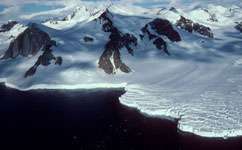Groundwater could fuel life under glaciers

Subglacial lakes in Antarctica might have nutrient-rich groundwater flowing into them, say scientists investigating the origin of the water in ice streams.
Ice streams are huge, fast-flowing glaciers that meander across Antarctica. They are responsible for nearly all of the Antarctic's contribution to sea-level rise, yet scientists have little understanding of where the water flowing through them comes from. This means that the contents of the subglacial lakes which lie underneath these streams is also a mystery.
The new research, published in Geophysical Research Letters shows for the first time where the water going in and out of these ice streams – their hydrologic budget – comes from.
'It's important to understand and quantify the hydrologic budget of these ice streams, as this can control the lubrication and ultimately how fast these ice streams move,' explains Dr Poul Christoffersen of the Scott Polar Research Institute, lead researcher on the study.
'Some of these glaciers are slowing, some are speeding up and that's all in response to changes in the configuration of sources and sinks of water. If we're trying to understand what they'll be doing in future we need to understand how they have behaved in the past.'
The team studied five ice streams. They found that the water flowing into them comes mostly from the ice sheet's deep interior. They also identified a large groundwater reservoir beneath these glacier, which the ice streams draw on to compensate when there is not enough water from the ice sheet to maintain the ice streams fast flow.
The team found that two of the streams moved much faster than three located further south.
'For two of the ice streams there was a balance between recharge and depletion so they continually flow fast, but for the other three the system doesn't have enough to provide replenishment, and so they end up losing water. Some are slowing down now, and one stopped altogether about 170 years ago,' Christoffersen says.
It's like when water from groundwater reservoirs flow into rivers in England. When an ice stream has little water flowing in from melting ice, the groundwater begins to flow into the stream instead. but unlike England it all happens beneath the ice. If this happens, and there's lots of groundwater in the network, then the connected subglacial lakes beneath the ice streams are likely to have a a much higher nutrient content, meaning researchers are more likely to find life in them than in the subglacial lakes fed by pure glacial water.
'Water that's been stored for thousands of years in the pore spaces of sediments beneath the ice streams are mixing with the water in the subglacial hydrological network. These ancient waters are full of nutrients from the sediment, enough that they could provide life to a thriving microbial habitat,' explains Christoffersen.
'A hydrologic system that receives groundwater contributions is much more likely to have high nutrient levels compared to the fast flowing systems which are fed by pure glacial meltwater. That water is pure with very little biochemical material to provide life,' he says.
More information: Christoffersen, P., M. Bougamont, S. P. Carter, H. A. Fricker, and S. Tulaczyk (2014), "Significant groundwater contribution to Antarctic ice streams hydrologic budget," Geophys. Res. Lett., 41, 2003-2010, DOI: 10.1002/2014GL059250.
Journal information: Geophysical Research Letters
Provided by PlanetEarth Online
This story is republished courtesy of Planet Earth online, a free, companion website to the award-winning magazine Planet Earth published and funded by the Natural Environment Research Council (NERC).
















